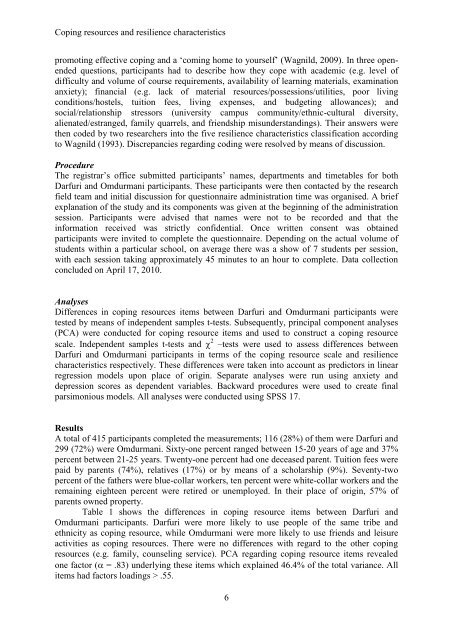Coping resources and resilience characteristics among - The Africa ...
Coping resources and resilience characteristics among - The Africa ...
Coping resources and resilience characteristics among - The Africa ...
Create successful ePaper yourself
Turn your PDF publications into a flip-book with our unique Google optimized e-Paper software.
<strong>Coping</strong> <strong>resources</strong> <strong>and</strong> <strong>resilience</strong> <strong>characteristics</strong><br />
promoting effective coping <strong>and</strong> a ‘coming home to yourself’ (Wagnild, 2009). In three openended<br />
questions, participants had to describe how they cope with academic (e.g. level of<br />
difficulty <strong>and</strong> volume of course requirements, availability of learning materials, examination<br />
anxiety); financial (e.g. lack of material <strong>resources</strong>/possessions/utilities, poor living<br />
conditions/hostels, tuition fees, living expenses, <strong>and</strong> budgeting allowances); <strong>and</strong><br />
social/relationship stressors (university campus community/ethnic-cultural diversity,<br />
alienated/estranged, family quarrels, <strong>and</strong> friendship misunderst<strong>and</strong>ings). <strong>The</strong>ir answers were<br />
then coded by two researchers into the five <strong>resilience</strong> <strong>characteristics</strong> classification according<br />
to Wagnild (1993). Discrepancies regarding coding were resolved by means of discussion.<br />
Procedure<br />
<strong>The</strong> registrar’s office submitted participants’ names, departments <strong>and</strong> timetables for both<br />
Darfuri <strong>and</strong> Omdurmani participants. <strong>The</strong>se participants were then contacted by the research<br />
field team <strong>and</strong> initial discussion for questionnaire administration time was organised. A brief<br />
explanation of the study <strong>and</strong> its components was given at the beginning of the administration<br />
session. Participants were advised that names were not to be recorded <strong>and</strong> that the<br />
information received was strictly confidential. Once written consent was obtained<br />
participants were invited to complete the questionnaire. Depending on the actual volume of<br />
students within a particular school, on average there was a show of 7 students per session,<br />
with each session taking approximately 45 minutes to an hour to complete. Data collection<br />
concluded on April 17, 2010.<br />
Analyses<br />
Differences in coping <strong>resources</strong> items between Darfuri <strong>and</strong> Omdurmani participants were<br />
tested by means of independent samples t-tests. Subsequently, principal component analyses<br />
(PCA) were conducted for coping resource items <strong>and</strong> used to construct a coping resource<br />
scale. Independent samples t-tests <strong>and</strong> 2 –tests were used to assess differences between<br />
Darfuri <strong>and</strong> Omdurmani participants in terms of the coping resource scale <strong>and</strong> <strong>resilience</strong><br />
<strong>characteristics</strong> respectively. <strong>The</strong>se differences were taken into account as predictors in linear<br />
regression models upon place of origin. Separate analyses were run using anxiety <strong>and</strong><br />
depression scores as dependent variables. Backward procedures were used to create final<br />
parsimonious models. All analyses were conducted using SPSS 17.<br />
Results<br />
A total of 415 participants completed the measurements; 116 (28%) of them were Darfuri <strong>and</strong><br />
299 (72%) were Omdurmani. Sixty-one percent ranged between 15-20 years of age <strong>and</strong> 37%<br />
percent between 21-25 years. Twenty-one percent had one deceased parent. Tuition fees were<br />
paid by parents (74%), relatives (17%) or by means of a scholarship (9%). Seventy-two<br />
percent of the fathers were blue-collar workers, ten percent were white-collar workers <strong>and</strong> the<br />
remaining eighteen percent were retired or unemployed. In their place of origin, 57% of<br />
parents owned property.<br />
Table 1 shows the differences in coping resource items between Darfuri <strong>and</strong><br />
Omdurmani participants. Darfuri were more likely to use people of the same tribe <strong>and</strong><br />
ethnicity as coping resource, while Omdurmani were more likely to use friends <strong>and</strong> leisure<br />
activities as coping <strong>resources</strong>. <strong>The</strong>re were no differences with regard to the other coping<br />
<strong>resources</strong> (e.g. family, counseling service). PCA regarding coping resource items revealed<br />
one factor ( = .83) underlying these items which explained 46.4% of the total variance. All<br />
items had factors loadings > .55.<br />
6


